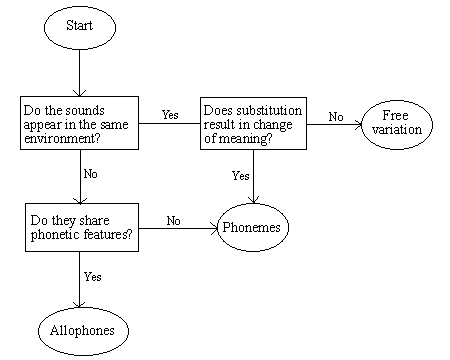When phonologists study the phonological system of a language, they
need to tell phonemes from allophones. They work along a line shown in
the following figure:

To illustrate this working procedure, let us look at some sounds of
Thai and English. In English, [ph]
and [p] never appear in the same environment,
and they share many features, so they are allophones of the same phoneme
/p/. In Thai (the major language in Thailand),
[paa] (‘forest’) and [phaa](‘to
split’) are a minimal pair. The aspirated voiceless bilabial stop and
the unaspirated voiceless bilabial stop are in the same position, and
the substitution of the two sounds changes the meaning of the words, so
we can be sure that the two sounds are separate phonemes. In English,
/![]() / and /h/
never appear in the same environment, but they do not share phonetic features,
so they are separate phonemes. In English,[wen]
and [
/ and /h/
never appear in the same environment, but they do not share phonetic features,
so they are separate phonemes. In English,[wen]
and [![]() en],
[wi
en],
[wi![]() ]
and [
]
and [![]() i
i![]() ],
etc., are heard, but they are not minimal pairs. The two initial sounds
are not in contrastive distribution, and the substitution does not change
meaning. Therefore, the two segments are in free variation.
],
etc., are heard, but they are not minimal pairs. The two initial sounds
are not in contrastive distribution, and the substitution does not change
meaning. Therefore, the two segments are in free variation.